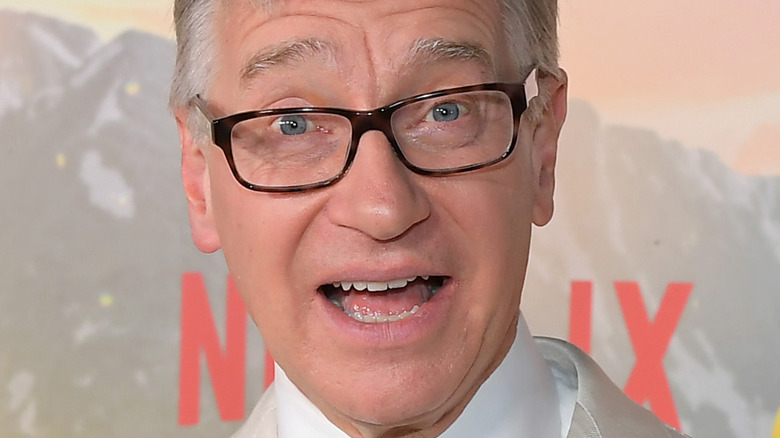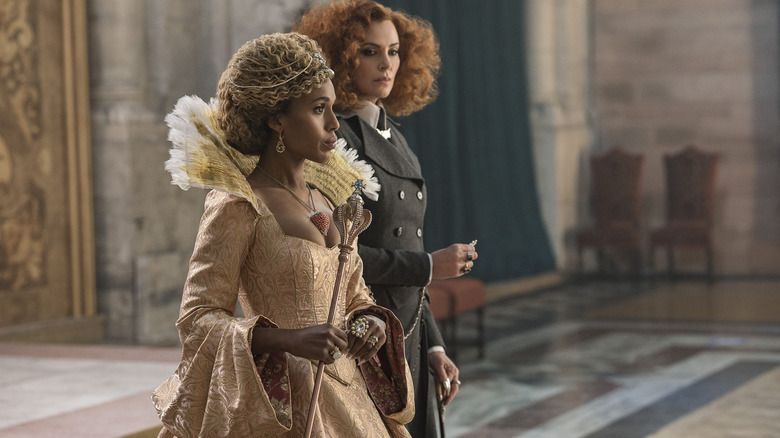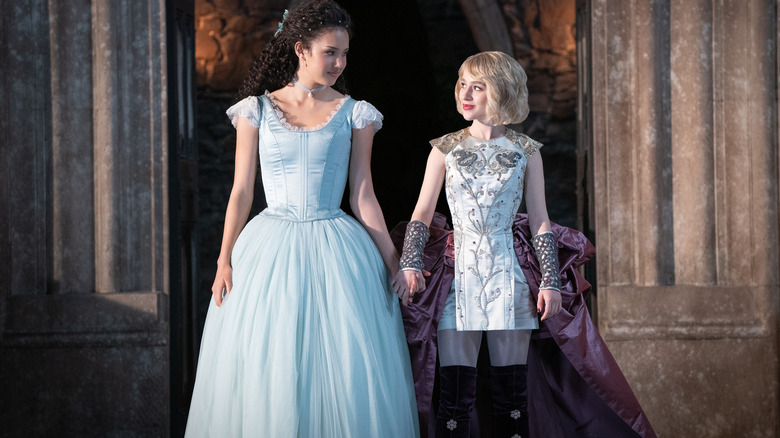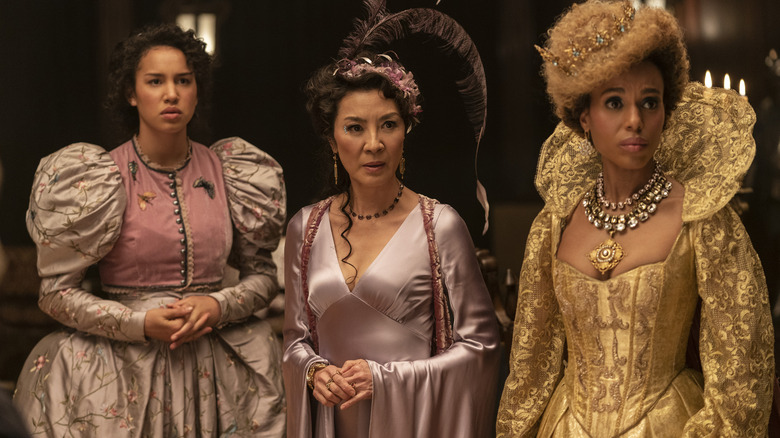Paul Feig Dives Deep On Making The School For Good And Evil - Exclusive Interview
Paul Feig is a director who isn't afraid to take some massive risks. He's primarily known for his work in comedy, getting his start directing episodes of some beloved TV classics, from "Freaks and Geeks" to "The Office." He parlayed that experience onto the big screen with the likes of "Bridesmaids" and "The Heat," but his resume is definitely looking a bit more eclectic these days.
He helmed the supernatural action-comedy "Ghostbusters" in 2016 and followed it up with the crime thriller "A Simple Favor." Now, he's ventured into the world of fantasy with his latest project, courtesy of Netflix, titled "The School for Good and Evil." Based on the book of the same name, the story follows two friends who end up in opposite schools and must learn to come face-to-face with their respective destinies.
Looper had the chance to talk with Feig in an exclusive interview about his latest film and what it was like to make something so different from what he's done in the past.
Getting introduced to The School for Good and Evil
When did you first become introduced to the book the movie's based on?
It was after I read the script, to be honest. The script got sent to me by Netflix over two and a half years ago, almost three years ago now, and I fell in love with the story. I'm always looking for great stories about female friendship but with three-dimensional women's roles in the leads. I thought it was such a wonderful way to tell the story of a friendship that's so strong that it can't be broken, even though it does get tested, and how the friendship actually is what saves them both in the end. That appeals to me the most. ...
Fantasy movies have never been my favorite genre, but when I read this, I [thought], that core story told through the fantasy genre could be even stronger because of all the things you can bring in, all the magic, and creating this new world. It can help with the stakes and make them different and bring a whole new dimension to storytelling.
Then on top of it, the meditation on good and evil is fascinating because we're so divided today. We're so much of the opinion that we're right and the other side is evil. Everybody's so black and white right now, and I love that the message of this, without being heavy-handed, [is], "We're all the same. We might have different opinions, but we're all human, and we're just trying to get through. Let's try to work it out and not be so extreme in our judgment of each other."
This is your first foray into the fantasy genre, for the most part. In the past, your films have taken place in the real world, maybe with supernatural elements, like [in] "Ghostbusters." What was it like to build a whole new world from the ground up?
It's catnip for a director because that's something I've always wanted to do. It was nice to have something that had no grounding in our reality. Obviously, when there's people and villages, it's still part of the Earth, but even Gavaldon, it was this unknown thing that doesn't exist. I'd always wanted to be able to design a very visual look from the ground up, but at the same time [I thought], "This is a story about a magic school. I wonder what we'll be compared to. How do we avoid the 'Harry Potter' thing?" It's always going to be there, so you can't totally avoid it, but design-wise, we could. So we leaned into, what's a different look for this?
I'm a big fan of art nouveau, having done a movie in Budapest, "Spy," back in 2014, and really carried that, and [Antoni] Gaudí. Then Andy Nicholson, my production designer, started going into obscure German architecture [as] a way to build a unique look for it.
With the costumes too, I wanted to get a ... "Harry Potter"'s got uniforms, and I didn't want to do uniforms anyway, even though they're in the book. [I] thought this is such a melting pot of all these different cultures and fairy tales from all over [the world]. Everybody would bring their own look and style, so that was fun, being able to sprinkle that around and design all these amazing costumes. Renee Kalfus, my great wardrobe and costumer, designed and built over 800 original costumes, including shoes and jewelry.
It's a blast. I love working with designers and conceptual artists. As a director, that's what you savor.
Drawing from other influences
What was the most difficult sequence to film in "The School for Good and Evil"?
They all have their challenges. We have a big battle scene at the end that was really fun to do. I shot a lot of it, [and] I had Melissa Stubbs doing second unit for me, and then Walter Garcia designing these amazing ... He's an inventive fight and stunt coordinator, but there's a lot of moving pieces in that. I shot a lot of it, and then they went and got a lot of the other bits and the stunts, but it took a long time. It took a number of weeks, so that was challenging.
Also, there's a big scene when we first meet the two schools where Tedros fights all the princes, then a Cyclops and Tedros fight, and there's a dance number from the princes. That was always looked at as the big behemoth when we were going to production [because it was] overloaded with fun stuff. Every movie ... It's so funny. You're excited each day, and you're filled with dread each day because you're like, "We got to shoot that giant scene." But the minute you're in, you get so filled with creativity. And having the actors doing it and all the technicians getting in there, it becomes a really exciting symphony that you're getting to conduct.
What movies did you look [to] for inspiration?
The thing with me [is], because I like to do a lot of different genres, the minute I decide on the genre I'm going to do and the project, I tend not to look at similar movies because I almost don't want to be influenced. I've seen enough stuff where it's in my head, but I want to have my own take on it. I dive immediately in with the designers and talk out the feel I want and what I don't want. Then, that's where it starts to become their ideas back to me, and then I'm weighing in. I do like that.
The danger of that sometimes is, you come up with something you think is original because you came up with it [and] you didn't see the other thing, but then everybody goes, "Well, they did that." It's like, "No, but that was my idea." But nobody cares because if it existed before, then all right.
One of the challenges we had was, with Rafal and Sophie's magic, we wanted to do something more than just finger glows. [We] originally didn't have the concept of blood magic, but that came up as we were putting things together and shooting some additional scenes. ... That felt like something we hadn't seen before. My VFX coordinator, Erik Nordby, wanted all our magic to be elemental so it felt it was of the Earth and felt very physical to the human body, even though clearly, it's still magic. We like the idea of grounding it in that way, so the blood magic felt like a cool way to do it. Then [when] the VFX team actually made it work, I [found] that very exciting. I'm really proud of that part of it because it adds a really weird element to things.
Deconstructing fantasy
The film deconstructs some of what we know about fairy tales and the concepts of good versus evil. It's not unlike what you've done before with "Spy" or "The Heat," with their respective genres. Is there anything in particular that draws you to stories that aim to deconstruct well-worn narratives?
Yeah, especially when you're doing comedy. But even if you want to inject any levity into anything, taking a genre ... That's why I love genres, because there's so many tropes that you can twist. We've seen before, you can twist people's expectations on what those tropes are going to be so they think they know what's coming, and then you actually flip it a little bit. I really like that.
What I also liked with this is, I was never a fan of fairy tales when I was a kid. I actually really disliked them because they're either way too scary, or they're way too simplistic [and] moralistic. When this project came up, it was almost like, "Oh, good. This is my revenge against all the fairy tales I didn't like because we can really tear them apart," like Agatha coming in as the audience and going, "You guys, this is really crazy what you're doing. It's cut and dry that it has nothing to do with how human beings actually function." That part was really fun for me.
Now that you've gotten a taste for the fantasy genre, is there any chance we might see you direct more movies like "The School for Good and Evil" in the future?
It depends. I'm hoping we get to do more of these. Once you build a world, you're like, "Cool. Let's have more fun with it. Let's have fun deconstructing that world again." But I seek out projects that speak to me story-wise, and once I find that, it's like, "How are we telling it?" If it can be through a different genre ... But I had a lot of fun doing this, and outside of doing more of these, if another one came up with a story and characters I found really compelling, I'd be tempted by it. I don't like to repeat myself if possible, but if you can tell an effective story and entertain an audience, that's number one, that's the calling. [How] you do it is icing on the cake.
"The School for Good and Evil" is now streaming on Netflix.
This interview has been edited for clarity.



